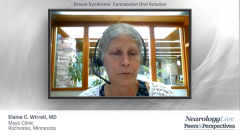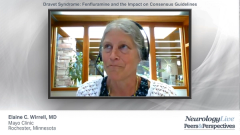
Treatment Goals of Dravet Syndrome
Experts discuss the goals of treatment of patients with Dravet syndrome regarding seizure freedom and seizure burden.
Episodes in this series

Joseph Sullivan, MD: Now we have our patient that’s either a new diagnosis of Dravet [syndrome] or has an established diagnosis but comes to us for a second opinion and just want to know what else can we try. We’re going to get into how far we’ve come in 2021, but what are your reasonable expectations in terms of having a conversation with a family that you’re meeting for the first time? What do you say is our treatment goal?
Elaine C. Wirrell, MD: Well, I think we’ve actually had a lot of excitement in this field. In the last few years, we’ve seen three new FDA [Food and Drug Administration]-approved medications for Dravet syndrome, which have higher efficacy than our other previous first-line medications that we use. So that’s very exciting to me and very exciting for the Dravet community for families. I still think that most of the time it’s not completely realistic to expect a 100% seizure freedom. I would love to think that ultimately, we are going be able to get there, but I do counsel my families that Dravet syndrome is a drug-resistant epilepsy and there will more than likely be breakthrough seizures. The goal is really to try and reduce that seizure burden, so particularly the prolonged seizures, the ones that are taking the kids into the ER, into the ICUs; we want to get rid of those. The convulsive seizures as well. We really want to reduce the seizure frequency because those are the ones that place those patients at highest risk of sudden unexpected death in epilepsy. Those are the ones we really want to focus on, and then some of the kids will also have pretty frequent absence seizures and almost go into an obtundation status or nonconvulsive status, and I think that also has a significant impact on development, so we need to be paying attention to those as well.
Joseph Sullivan, MD: Absolutely. I think just framing it with some optimism that, “Look, I’m having this conversation with you now, but it is a very different conversation than I would have had with you had we met 5 years ago.”
Elaine C. Wirrell, MD: Absolutely.
Joseph Sullivan, MD: Still tempering great things, but we still have a long way to go, and I know there was that paper that came out of the European survey that looked at over 500 kids with Dravet, and it was only 10% to 15% that had experienced no seizures in the prior 3 months. Now, that is before some of these new treatments that we’re going to talk about here shortly, but I think that puts it into context. If a child was doing well for 2 to 3 months, you can be grateful for that, but at the same time don’t be devastated. It’s hard for me, as [I am] not a caregiver of someone with Dravet. Of course, they’re going to feel devastated because they finally feel they get this period, but to at least acknowledge that 3 months is actually good and we’re still going to try to do better. Certainly, we need to be very mindful of side effects. With our other non-Dravet patients, I’m very mindful of piling on more than 3 medications and I think that actually, we’ve learned a lot with Dravet too, that 2 to 3 medicines is probably a sweet spot. Again, I say that with caution, as I do have some [patients] for [whom more medication] does seem to be working for them, and they tolerate it, but be mindful of if you’re talking about adding a 3rd medication to medication 1 and 2, you’re acknowledging that 1 and 2 are not as effective as you’d like them to be.
Elaine C. Wirrell, MD: Maybe you wanted them to go.
Joseph Sullivan, MD: Exactly. I think that’s obviously anxiety-provoking for families. I think for other clinicians, they’re like, “Why would you want to take something away? They’re still having seizures.” It’s a leap of faith. When I’m writing out the decrease I have to admit, I get a little bit squeamish, but I think unless we try to do that, that’s where we can avoid having our kids and young adults on so many medications. Then you’d be really getting into the quandary of what’s doing what…and then what do you appeal back?
Thank you for watching this Neurology Live® Peers & Perspectives®. If you enjoyed the content, please subscribe to our e-newsletters to receive upcoming programs and other great content in your inbox. Thank you so much.
Transcript Edited for Clarity
Newsletter
Keep your finger on the pulse of neurology—subscribe to NeurologyLive for expert interviews, new data, and breakthrough treatment updates.






































